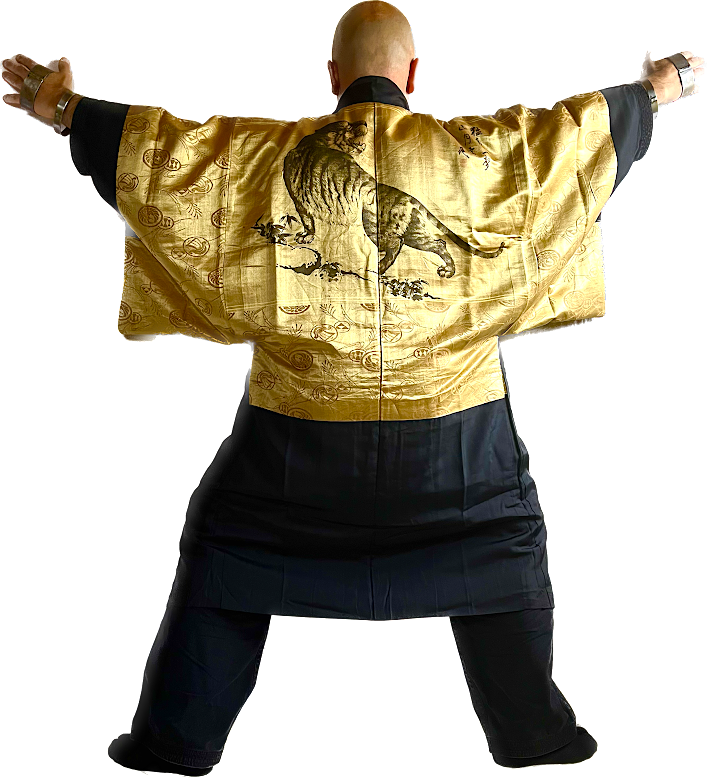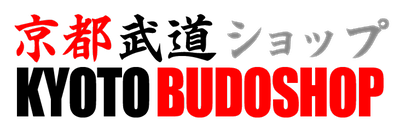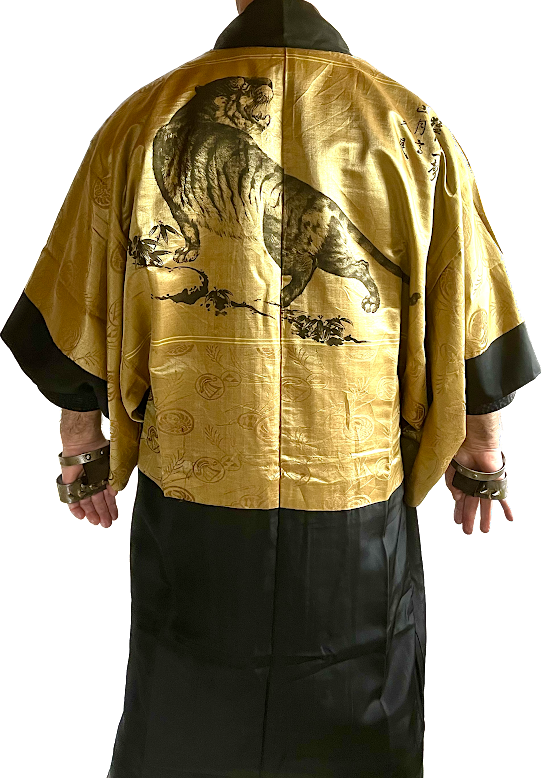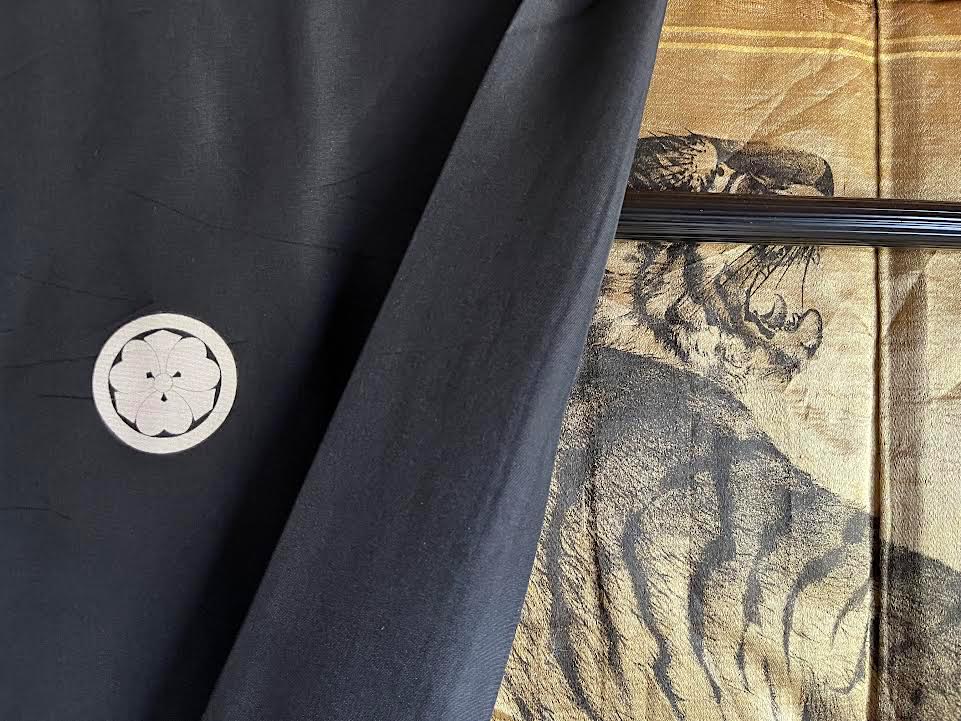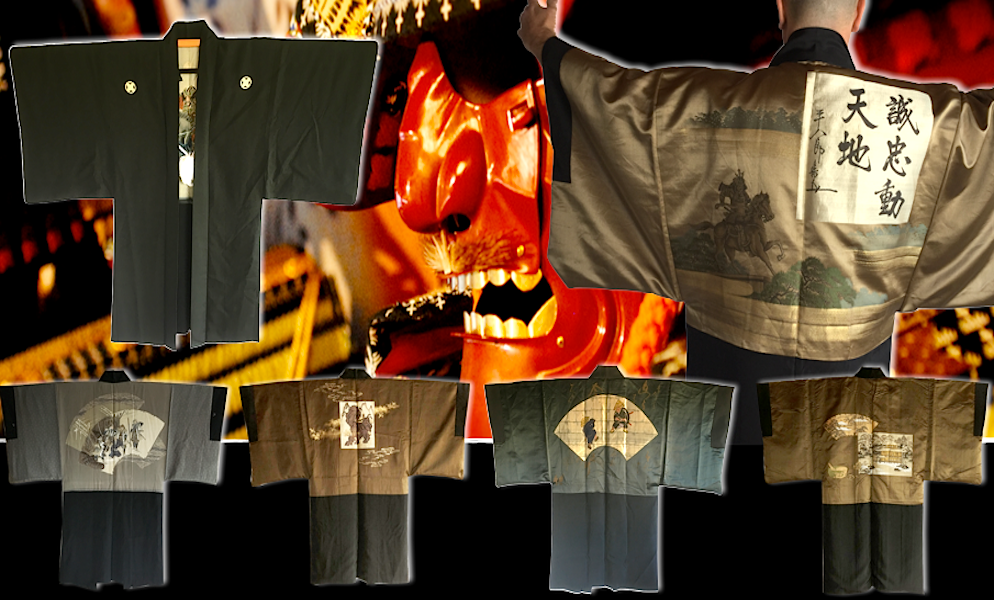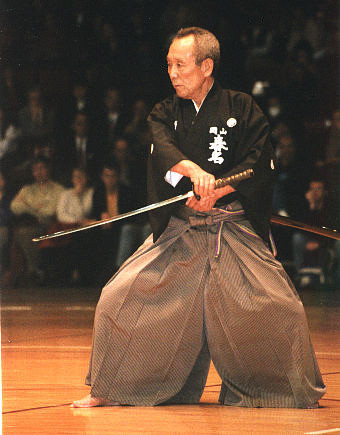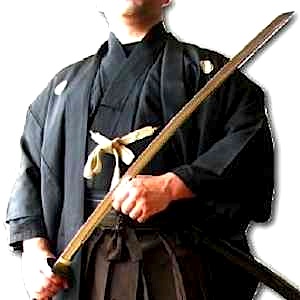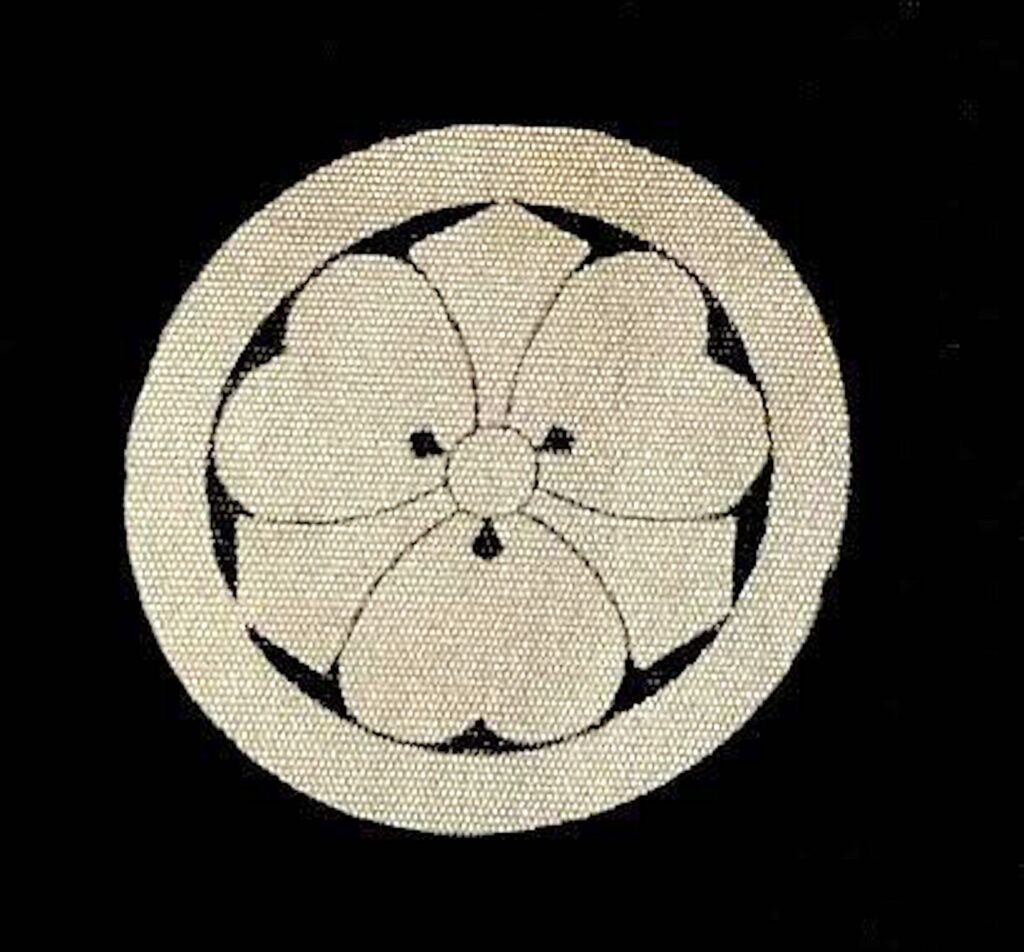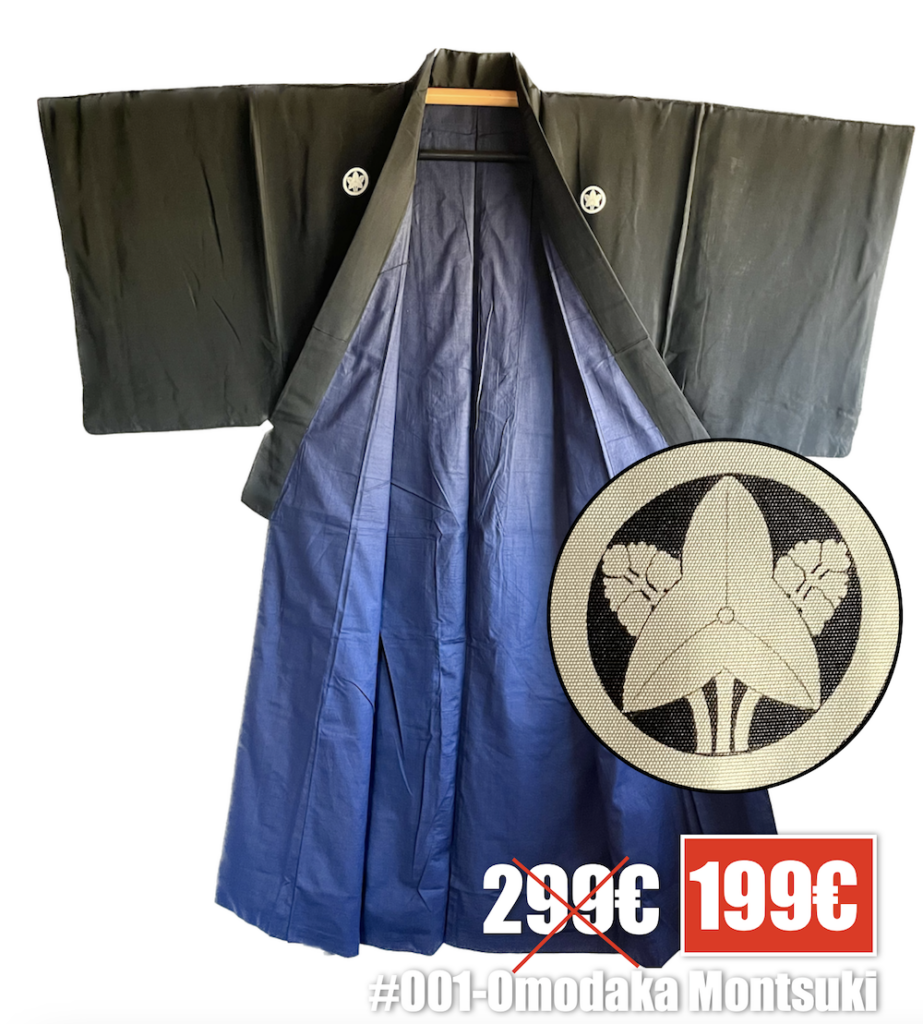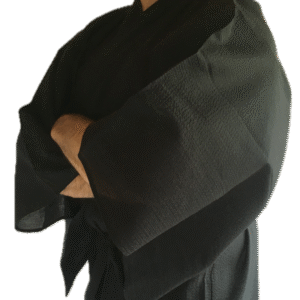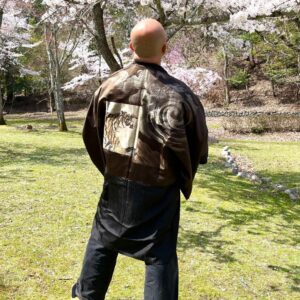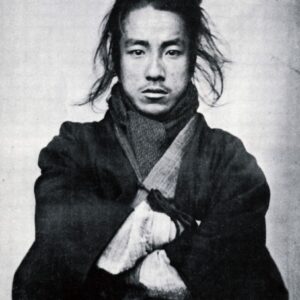Tout savoir sur le Haori homme
Dans cet article, nous allons tout savoir sur le haori japonais pour homme : son origine historique, sa forme traditionnelle, les différents types de haori masculins, sa méthode de fabrication artisanale, les tissus et textiles utilisés pour sa confection, ainsi que ses types d’utilisation authentique dans un contexte traditionnel ou plus urbain et contemporain.
1) Origine du Haori japonais Homme
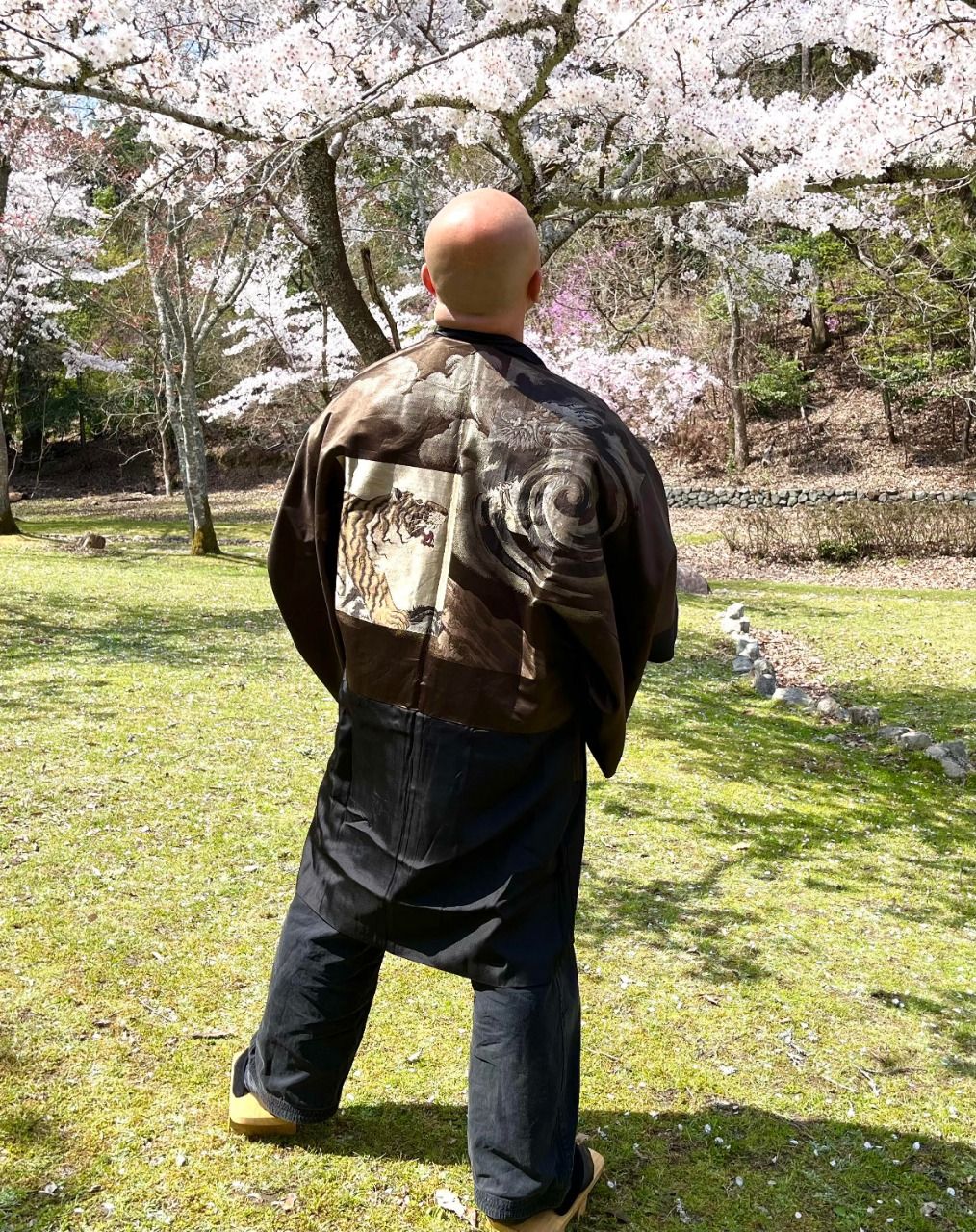 Le haori est un vêtement traditionnel japonais qui a une longue histoire remontant au 8ème siècle, à l’époque de Nara. Initialement porté par la noblesse de cour, sa fonction première était de protéger les riches kimonos des intempéries. Au départ, le haori arborait le blason familial (mon) pour identifier les différents clans de la haute société japonaise.
Le haori est un vêtement traditionnel japonais qui a une longue histoire remontant au 8ème siècle, à l’époque de Nara. Initialement porté par la noblesse de cour, sa fonction première était de protéger les riches kimonos des intempéries. Au départ, le haori arborait le blason familial (mon) pour identifier les différents clans de la haute société japonaise.
Il s’est par la suite démocratisé auprès de toutes les classes sociales aux alentours du 17ème siècle pendant l’époque d’Edo. Des versions plus simples et moins coûteuses apparaissent. Le haori en lin, en chanvre ou en coton devient accessible au peuple. Tout en symbolisant le statut social de celui qui le porte, à l’époque Edo, sua fonction évolue également vers un vêtement de style.
Aujourd’hui, le haori fait partie intégrante du kimono masculin traditionnel et continue d’être populaire lors de cérémonies, d’occasions spéciales, ainsi que dans la pratique de certaines formes d’arts martiaux comme le iaido. Veste iconique au Japon, le haori traverse les siècles tout en préservant la richesse de l’artisanat et du patrimoine nippon.
2) Quelle est la coupe du Haori Homme ?
Le haori pour homme a une forme similaire à celle d’une veste, avec des manches larges et un col court. Il est ouvert à l’avant, avec une seule rangée de boutons ou de crochets pour le maintenir en place. La longueur du haori peut varier, allant du milieu de la taille jusqu’aux genoux.
Les manches du haori sont souvent amples et tombantes pour permettre une grande amplitude de mouvement. Elles sont fixées au corps du haori par des coutures plates pour plus de confort. Au niveau des emmanchures, on retrouve fréquemment des fentes latérales pour faciliter les gestes.
Le haori homme présente également des épaulettes carrées qui apportent une structure et un tombé élégant au vêtement. Sa coupe droite ample permet de le porter aussi bien ouvert que fermé, sur d’autres types de tenues comme le kimono traditionnel ou des tenues plus modernes.
Conçu dans des matières souples et confortables, à la fois pratique et élégant avec ses ornements raffinés, le haori pour homme est un vêtement polyvalent traversant les époques et les styles.
3) Existe-t-il différentes tailles de haori homme ?
Oui, il existe différentes tailles de haori pour homme :
- Taille unique : Certains haoris sont conçus dans une taille unique assez ample et modulable qui conviendra à la plupart des hommes.
- Petites, moyennes, grandes et extra-grandes tailles : D’autres haoris sont déclinés dans les tailles standards, du S au XXL environ, pour s’ajuster au mieux à la carrure du porteur.
- Sur-mesure : Les haoris traditionnels portés lors des cérémonies formelles sont eux fréquemment confectionnés sur-mesure, avec les motifs familiaux. Un artisan prend alors les mesures précises du client.
- Tailles libres : Enfin, il existe des haoris sans taille indiquée, plutôt oversize, où l’ampleur permet de jouer sur les superpositions avec les autres vêtements.
Ainsi selon le style de haori, son usage et les matières employées, les coupes, longueurs et largeurs s’adapteront davantage à la morphologie masculine. N’hésitez pas à essayer le haori pour trouver la taille la plus confortable et flatteuse.
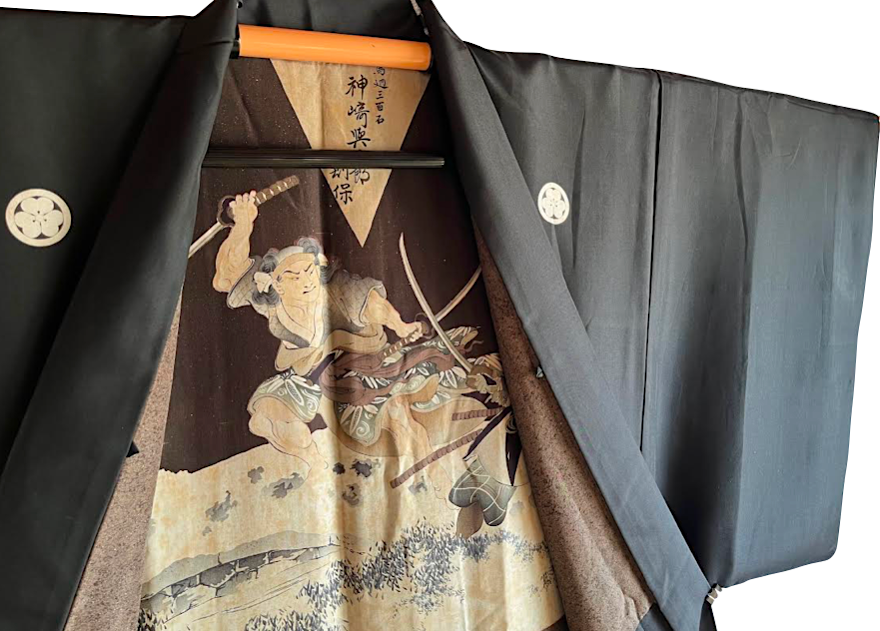
4) Quels sont les différents types de Haori Homme ?
Il existe plusieurs types de haori pour homme qui se distinguent par leur coupe, leur tissu et leur utilisation. Voici quelques exemples :
- Haori de cérémonie : C’est un haori très formel qui est généralement en soie, richement brodé et orné de motifs complexes comme des blasons familiaux (kamon). Il est porté lors d’occasions solennelles comme les mariages traditionnels, les cérémonies du thé ou encore certains festivals.
- Haori de montagne :Fabriqué dans un tissu épais et résistant comme le coton ou la laine, ce haori protège du froid et des intempéries en randonnée ou alpinisme. Sa coupe ample permet une grande liberté de mouvements.
- Haori de ville : Plus raffiné, le haori de ville est confectionné dans des matières nobles comme la soie ou le lin. Son style épuré convient pour des occasions urbaines comme des dîners au restaurant ou des soirées.
- Haori de pratique d’arts martiaux : Ce modèle est spécialement conçu pour la pratique des arts martiaux japonais avec un tissu solide, absorbant la transpiration. On le retrouve souvent en coton épais ou polyester lors des entraînements de kendo, judo ou aikido.
- Haori décontracté : Version plus courte et légère du haori traditionnel, il arbore des couleurs vives ou des motifs modernes. Idéal pour une sortie entre amis ou un événement casual.
Chaque type de haori homme a ses propres caractéristiques, et il est important de choisir le bon type en fonction de l’occasion et des conditions climatiques.
5) Quelle est la méthode de Fabrication du Haori Homme ?
Le haori japonais pour homme est traditionnellement fabriqué à la main par des artisans qualifiés. Voici les étapes de fabrication typiques :
- Conception : Le processus de fabrication commence par la conception du haori. Le client peut choisir un modèle existant ou demander un modèle personnalisé. Le motif, le tissu et les finitions sont choisis en fonction des goûts du client et de l’utilisation prévue du vêtement.
- Coupe du tissu : Une fois la conception finalisée, le tissu est coupé en fonction des mesures du client. Le tissu peut être coupé à la main ou à l’aide d’une machine à coudre.
- Assemblage : Les différentes pièces du haori sont ensuite assemblées. Les manches sont cousues sur le corps du haori, les poches sont cousues en place et les boutons ou les crochets sont fixés.
- Finitions : Les finitions, telles que la doublure, les broderies ou les bordures, sont ensuite ajoutées. Les finitions peuvent être réalisées à la main ou à l’aide d’une machine à coudre, en fonction du niveau de détail requis.
- Pressage : Le haori est ensuite pressé à la vapeur pour lui donner sa forme finale et le rendre prêt à être porté.
La méthode de fabrication peut varier en fonction du type de haori et de la technique utilisée. Certaines étapes, comme la broderie, peuvent être réalisées à la main pour ajouter des détails personnalisés. Le processus de fabrication du haori japonais pour homme est un travail minutieux qui nécessite une grande attention aux détails et un savoir-faire traditionnel transmis de génération en génération.
6) Quels sont les tissus utilisés pour la confection du Haori homme ?
Le haori japonais pour homme peut être fabriqué dans une variété de tissus différents, chacun ayant ses propres caractéristiques et utilisations.
Voici quelques exemples de tissus couramment utilisés pour le haori :
- Soie : La soie est un choix populaire pour les haoris de cérémonie, car elle est luxueuse et légère. La soie est également respirante, ce qui la rend confortable à porter pendant les mois chauds.
- Coton : Le coton est souvent utilisé pour les haoris de montagne et les haoris de pratique d’arts martiaux, car il est durable et résistant. Le coton est également respirant et absorbant, ce qui le rend confortable à porter pendant les mois chauds.
- Lin : Le lin est un tissu léger et respirant qui est souvent utilisé pour les haoris de ville. Il est également résistant, ce qui le rend approprié pour une utilisation quotidienne.
- Polyester : Le polyester est un tissu synthétique résistant qui est souvent utilisé pour les haoris de pratique d’arts martiaux. Il est facile à entretenir et résiste bien à l’usure.
- Laine : La laine est un tissu chaud et isolant qui est souvent utilisé pour les haoris d’hiver ou de montagne. Elle est également douce et confortable à porter.
Chaque type de tissu a ses propres avantages et inconvénients, et il est important de choisir le tissu approprié en fonction de l’utilisation prévue et des conditions climatiques.
7) Où sont fabriqués les Haori Homme au Japon ?
Au Japon, la fabrication des haoris pour homme fait appel à un savoir-faire artisanal préservé et transmis depuis des siècles. Quelques précisions sur les lieux de production :
- A Kyoto, une des capitales historiques du Japon, il existe encore de nombreux ateliers spécialisés dans la confection traditionnelle des haoris selon les méthodes ancestrales : tissage, découpe, assemblage et finitions mains. Les motifs des étoffes et les broderies sont particulièrement sophistiqués.
- La région de Hokkaido, au nord du Japon, est réputée pour ses haoris en laine et lin de grande qualité, parfaits pour l’hiver rude. Les tissages, teintures et impressions y sont très développés.
- Dans les campagnes de l’île de Honshū comme à Takayama subsistent aussi des tisserands produisant la soie et le coton des haoris dans un esprit traditionnel.
- La ville de Kojima dans la préfecture d’Okayama concentre la fabrication de jeans japonais avec lesquels sont confectionnés des haoris contemporains urbanisés.
- Enfin, Tokyo et Osaka proposent des versions modernisées mêlant matières traditionnelles précieuses et coupes ajustées pour séduire une clientèle citadine et jeune.
En conséquence, le Japon conserve un riche tissu de PME et d’ateliers artisanaux dédiés à la production de haoris de grande qualité avec des spécificités régionales fortes.
8) Comment porter le Haori japonais traditionnel homme ?
Voici quelques types d’utilisation traditionnelle et urbaine :
Le haori japonais pour homme est un vêtement polyvalent qui peut être utilisé dans une variété de contextes traditionnels et urbains. Voici quelques exemples d’utilisation courante du haori :
- Cérémonies : Le haori est souvent porté lors de cérémonies traditionnelles telles que les mariages, les funérailles, les cérémonies du thé et les festivals. Il peut être porté seul ou avec un kimono.
- Arts martiaux : Le haori est également utilisé dans les arts martiaux tels que l’iaido, le kendo et l’aikido. Il est porté sur un keikogi pour fournir une couche supplémentaire de protection et de chaleur.
- Vie quotidienne : Le haori est également un choix populaire pour une utilisation quotidienne, en particulier dans les environnements professionnels. Il peut être porté avec des pantalons habillés et une chemise pour créer un look élégant et formel.
- Mode urbaine : Le haori est également devenu populaire dans la mode urbaine japonaise. Il peut être porté avec des jeans et des baskets pour un look décontracté et moderne.
- Déguisements : Le haori est également utilisé comme costume pour les événements costumés et les festivals d’Halloween.
Le haori est donc un vêtement polyvalent qui peut être utilisé dans une variété de contextes traditionnels et modernes. Sa polyvalence et sa beauté en font un choix populaire pour ceux qui cherchent à ajouter une touche de style japonais à leur garde-robe.
9) Comment nouer le Haori Homme ?
Voici les étapes pour nouer un haori homme de façon traditionnelle :
- Mettez le haori par-dessus votre kimono, côté droit d’abord. Le côté gauche se croisera par-dessus le côté droit lorsque vous nouerez.
- Prenez le cordon intérieur attaché au haori du côté gauche dans votre main gauche. Prenez le cordon extérieur attaché au haori du côté droit dans votre main droite.
- Croisez le côté gauche sur le côté droit et tenez les deux cordons parallèles l’un à l’autre, main gauche sur le dessus. Formez un nœud en cousin en tournant le poignet gauche sur le poignet droit.
- Ajustez le nœud en cousin au centre de la poitrine et serrez bien pour que le haori soit maintenu fermé. Le côté gauche se superpose sur le côté droit comme le veut la tradition.
- Rentrez les extrémités des cordons sous le nœud pour qu’elles ne pendent pas de chaque côté. Vous pouvez aussi les passer dans la doublure du haori pour plus de propreté.
Et voilà, votre haori homme est noué de façon traditionnelle ! Les motifs familiaux sont bien visibles sur le dos et les manches larges vous permettent une aisance de mouvement.
10) À quelle(s) saison(s) peut-on porter le haori homme ?
Le haori homme est un vêtement versatile que l’on peut porter tout au long de l’année. Voici un résumé des périodes les plus adaptées aux différents types de haori :
- Printemps : C’est la saison idéale pour porter un haori léger en coton, soie ou lin. Les modèles courts à manches courtes conviendront parfaitement avec cette météo douce.
- Été : Sur un tee-shirt ou une chemise en coton, le haori d’été en lin ou soie sans doublure intérieure sera très agréable quand les températures montent.
- Automne : Les haoris en laine fine ou mélangés à d’autres fibres naturelles tiendront chaud lors des soirées plus fraîches. On peut même superposer deux haoris légers.
- Hiver : C’est le moment de sortir les haoris matelassés et rembourrés, en laine épaisse, flanelle ou velours côtelé. Pour les sportifs, rien ne vaut le haori imperméable coupe-vent.
- Toute l’année : Certains haoris polyvalents en coton ou mélanges résistants, de poids moyen, peuvent être portés presque toute l’année en ajustant les couches en-dessous.
Le haori japonais suit bien les saisons ! N’hésitez pas à varier les versions, matières et longueurs de manches selon la météo.
11) Avec quels types de vêtements peut-on assortir le haori homme ?
Le haori homme se marie avec différents types de vêtements et permet des looks traditionnels ou plus modernes. Voici quelques propositions d’association :
- Pour un style authentique japonais : portez le haori par dessus un kimono, des sandales geta et des tabis (chaussettes traditionnelles).
- En smart casual : associez-le avec un jean, un t-shirt et des baskets pour une touche streetwear.
- En explorer urbain : sur une chemise ou une marinière et un pantalon chino, avec des derbies ou des richelieus.
- En gentleman campagnard : par-dessus un pull en maille, un pantalon de costume et des boots rangers.
- En dandy romantique : superposez-le sur une chemise à jabot ou à dentelle, avec un pantalon cigarette et des mocassins.
- En mode sportswear : portez votre haori sur un jogging, un débardeur et des baskets pour un look décontracté.
Le haori homme révèle tout son potentiel contemporain en le mixant aussi bien avec des pièces traditionnelles qu’avec des vêtements casual, chics ou sportswear. Amusez-vous à composer des associations qui vous ressemblent !
12 ) Comment prendre soin et entretenir le haori homme ?
Voici quelques conseils pour prendre soin et entretenir un haori homme :
- Lisez bien l’étiquette pour identifier la composition du tissu avant tout lavage. Certains haoris traditionnels nécessitent un nettoyage à sec.
- Pour les haoris en coton, lin ou soie, lavez à la main à l’eau froide pour préserver la couleur et les broderies. Utilisez une lessive douce ou du savon de Marseille.
- Pour les haoris plus épais en laine, cashmere ou velours côtelé, nettoyez à sec ou faites un lavage délicat en machine à basse température avec une lessive adaptée.
- Séchez toujours à plat, à l’air libre et à l’ombre pour éviter le rétrécissement ou la déformation du vêtement. Repassez si besoin à basse température.
- Pour le stockage, pliez votre haori avec soin sur un cintre ou dans une housse. Évitez les matières plastiques qui emprisonnent l’humidité.
- Faites vérifier les coutures et réparations par un professionnel si besoin pour assurer la longévité de votre haori.
Avec un bon entretien, votre haori homme pourra traverser les années et vieillir avec élégance ! Sa qualité et ses broderies n’en seront que plus mises en valeur.
13 ) Comment ranger son Haori Homme ?
Voici quelques conseils pratiques pour bien ranger votre haori homme :
- Utilisez un cintre adapté à la délicatesse des tissus. Préférez les cintres larges recouverts de tissu ou de bois pour ne pas marquer les épaules.
- Vous pouvez également plier avec soin votre haori à plat pour le ranger. Choisissez un endroit sec à l’abri de la lumière dans votre dressing, comme un tiroir ou une étagère.
- Si votre haori est en matière fragile (soie, lin), rangez-le de préférence dans une housse en coton ou une boîte en carton de conservation pour le protéger. Évitez le plastique qui manque de transpiration.
- Glissez des sachets anti-mites dans les plis et autour du vêtement pour le préserver des insectes. Vérifiez régulièrement leur état.
- Si votre haori est fourré, brosser délicatement le tissu extérieur avant de le ranger pour ôter poussières, poils et peluches.
- Lorsque vous sortez votre haori après un certain temps, laissez-le respirer quelques heures à l’air libre avant de le porter pour éliminer l’humidité et les odeurs de renfermé.
En prenant le temps de bien ranger votre haori homme après chaque utilisation, vous prolongerez sa durée de vie et garderez intact son aspect visuel.
14) LE HAORI FORMEL HOMME
Les ornements du haori homme
Le haori japonais pour homme peut être orné de différents éléments décoratifs tels que des mon (blasons), des broderies, des motifs tissés ou des motifs imprimés. Les ornements peuvent être placés sur le dos, les épaules, les manches ou le col du haori. Les choix d’ornements dépendent souvent du type de haori et de l’occasion pour laquelle il est porté.
Parmi les ornements traditionnels, on retrouve les kamon (blasons familiaux), les motifs symboliques comme le pin, la grue ou la carpe koï, ainsi que des broderies représentant des paysages ou des scènes de la nature. Pour les occasions formelles, des fils d’or ou d’argent peuvent être incorporés.
Sur les haoris plus contemporains, les imprimés tendance comme les fleurs, les lignes géométriques, les rayures ou les motifs ethniques sont populaires, de même que les kanji (idéogrammes) formant des messages ou des proverbes.
Que le style soit classique ou moderne, les ornements du haori reflètent l’histoire et la personnalité de celui qui le porte

Les Armoiries « Kamon » du Haori japonais homme
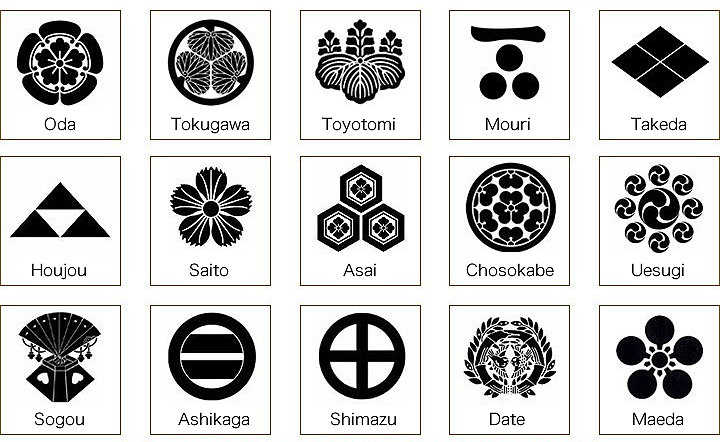
Les Kamon : Symboles Familiaux et Historiques au Japon
Les kamon, connus aussi sous le nom de mon, sont des emblèmes familiaux ou claniques adoptés au Japon dès le 12ème siècle pour distinguer les différentes familles ou clans. Originaires de l’ère des samouraïs, ces symboles étaient arborés sur les vêtements, bannières et armures, incarnant l’identité et l’honneur des lignées guerrières.
D’une grande diversité, les kamon se déclinent en une multitude de formes et de styles, reflétant l’histoire, les exploits et les croyances des clans. De simples motifs géométriques aux représentations complexes d’animaux mythiques, chaque kamon porte en lui l’essence et la fierté de son héritage.
Les kamon les plus courants comprennent le kikumon, symbolisant noblesse et immortalité, le mitsudomoe représentant force et harmonie, ou encore le maru-ni-mokkou évoquant unité et prospérité. Les couleurs utilisées, telles que le rouge pour la vitalité, le bleu pour la paix, ou le noir pour l’autorité, revêtent également une signification profonde dans la culture japonaise.
Au-delà de leur aspect décoratif et distinctif, les kamon sont des porte-bonheurs, transmettant les valeurs et l’histoire familiales de génération en génération. Ils renforcent les liens entre membres d’une même lignée, portant l’espoir d’une chance et d’une prospérité durables pour les descendants à venir.
- Types et Formes des Kamon
- Variété de formes et de types reflétant l’histoire et les croyances
- Simples : cercles, carrés, motifs floraux
- Complexes : animaux mythiques, éléments naturels, idéogrammes
- Exemples de Kamon :
- Kikumon (fleur de chrysanthème)
- Mitsudomoe (trois tomoe entrelacés)
- Maru-ni-mokkou (cercle avec quatre pétales)
- Fuji (motif de glycine)
- Hiragana de la famille ou du clan
- Variété de formes et de types reflétant l’histoire et les croyances
- Couleurs et Motifs Significatifs
- Importance des couleurs et des motifs dans la symbolique japonaise
- Rouge : vitalité et bonheur
- Bleu : paix et sérénité
- Vert : croissance et fertilité
- Jaune : richesse et prospérité
- Violet : noblesse et mystère
- Noir : puissance et autorité
- Motifs symboliques :
- Carpes koï : persévérance et réussite
- Grues : longévité et fidélité conjugale
- Pins : force et résilience
- Importance des couleurs et des motifs dans la symbolique japonaise
- Signification et Utilisation des Kamon
- Décoratifs et identitaires, utilisés sur les haoris japonais
- Porte-bonheur représentant l’histoire et les valeurs familiales
- Transmission de génération en génération, renforçant les liens familiaux et claniques
Les Kamon, bien plus que des blasons, incarnent l’héritage et les aspirations des familles et des clans japonais, portant en eux la richesse de toute une histoire et la promesse d’un avenir prospère.
